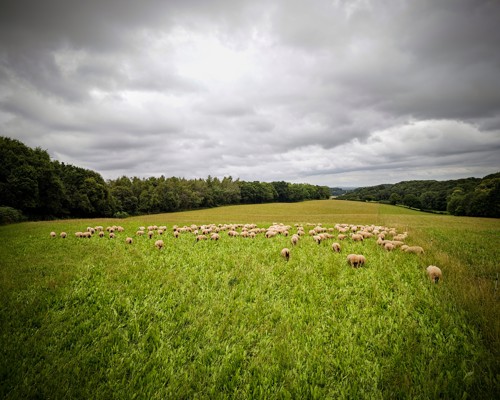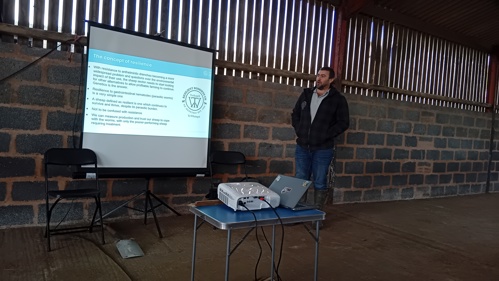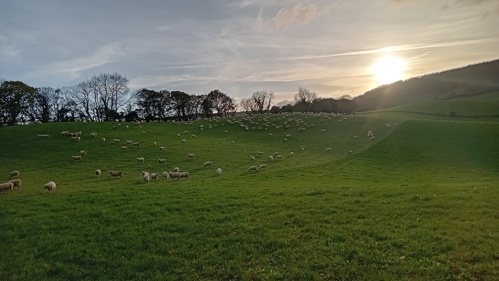Worms are a common parasite affecting lambs, traditionally managed using anthelmintics (a class of drugs used to treat parasitic infections). However, the growing issue of anthelmintic drench resistance and the costs associated with lower growth rates in the lambs affected have prompted producers to explore alternative strategies.
A field lab supported through Farm Net Zero has been exploring using chicory-rich leys to improve lamb health and resilience, with a focus on building resilience rather than resistance.

Farmers in Devon and Cornwall have shared their insights from the field lab. Their experiences revealed three practical strategies:
- Breeding for resilience
- Optimising diet
- Smart pasture management
The difference between resistance and resilience in worm management
“Worm resilience is a highly heritable trait,” explains Matt Smith of Trefranck Farm. In New Zealand, farmers have long focused on breeding sheep for resilience. Matt has brought this expertise to Cornwall, importing Romney rams with robust genetics.
He notes, “Worms don’t want to kill their sheep host, but coexist with them.” In the UK, however, overreliance on anthelmintics has resulted in sheep with lower resilience. By selecting the right breeds, you can ensure healthy sheep thrive even with worms. Only weaker sheep should require anthelmintics, ensuring the medicine is used as needed rather than as a blanket solution.

Matt has recently been involved in a study which concluded that resilience could be improved by selectively breeding from the most resilient sires, i.e. those with good daily liveweight gain despite high worm burden. A recent study he was involved in showed that ram lambs with highest resilience to worm burdens were 10 days ahead of the least tolerant lambs. Resilient lambs may mature more slowly, but suffer less from burden once matured.
Optimising diet for healthy, resilient lambs
Nutrition is critical for lambs to naturally manage gut parasites. Field lab participants tested chicory-rich cover crop and herbal ley mixes, known for their anthelmintic properties. Beyond their potential to combat worms, diverse forage blends can deliver higher levels of protein, nutrients and liveweight gain than grass clover leys.

Herb and legume forage species are important for maximising feed intake. Clovers and herbs digest faster than grass in the rumen, allowing lambs to graze more often and absorb nutrients more efficiently. While grass can take up to six hours to digest, plants like chicory and plantain are processed in just two to two-and-a-half hours, supporting faster energy use, more efficient grazing and potentially leaving more time for stock to rest, ruminate and engage in other natural behaviours.
Herbs and legumes also provide valuable minerals. Deep-rooted plants like chicory and plantain draw nutrients from the soil, resulting in richer, more beneficial feed. While their anthelmintic properties are often highlighted, their greatest advantage may lie in improving overall lamb health, which will naturally result in greater worm resilience.
Monty White from DLF seeds recommends the optimum legume % for a specialist lamb finishing mix would be 25-30%. Not only will this provide nitrogen for the herbs and grass but also will provide high protein feed that will drive liveweight gain.
In terms of ideal percentage of grass, legumes and herbs: For a specialist finishing mix Monty recommends 45% grass, 30% herbs, 25% legumes. For more of an all-round system herbal ley, DLF seeds Herbal Max Gold is 65% grass, 18% Legume, 17% Herbs.
Smart pasture management to optimise resilience in your livestock
Rotating livestock through fields is another important aspect of minimising the impact of worms. Devon farmer Chris Berry rotates sheep through fields and follows them with ewes or mature cattle, which help "mop up" parasites left behind by lambs. Ewes, being more resilient to worms than lambs, are better equipped to handle parasite exposure. Factors such as immunity, life stage, and diet make ewes less vulnerable. This practice reduces parasite build-up in pastures and helps maintain healthy grazing conditions for lambs.

Making the most of SFI payments
Sustainable Farming Incentive (SFI) payments for herbal leys provide an excellent opportunity to trial new seed mixes tailored to your farm. As Matt Smith emphasises, “If we’re not making these changes while the SFI payments are available, they’ll disappear - and we’ll miss out.”
Investing in high-quality seed mixes may cost more upfront but delivers significant long-term benefits. These include improved livestock performance, healthier soils, and better water retention. A tailored approach to managing worm burden with diverse leys can yield healthier lambs, resilient pastures, and stronger overall results.
Liveweight gain in kilos per hectare
| Farm | Forage rape | Plantain/ chicory | Herbal ley | Grass |
| Trefranck | - | 228 | 178 | 135 |
| Higher Thornton | 185.6 | 222 | 61.6 | 54 |
The herbal ley results are down for Higher Thornton - this is an outlier result that's not indicative of the herbal leys but due to the particularly challenging growing conditions in that field.
Learnings and tips on establishing and managing herbal leys and diverse cover crops include:
- The trial herbal ley established much better after cultivation than the direct drilled area. Earthworm populations in the cultivated area recovered fully and soil structure was very good. “It is better value to cultivate so you guarantee good establishment in year one.”
- Herbs typically last a maximum of 2-3 years in a ley but this depends on the pasture; managed well, Matt managed 4-5 years from a GS4 mix.
- Plantain is very effective at stitching back in compared to other herbs. If you notice stock rejecting plantain, it may be old and unpalatable.
- The group would switch to red clover in the mix as it is more vigorous than crimson clover.
- Cocksfoot is less frequently selected by lambs than other species in the ley, so you can either top after grazing, or bring in cows to mop up the cocksfoot, in order to control its dominance
- Findings in a separate field lab have found grazing ewes on herbal leys containing red clover can have a positive effect on pregnancy rate (contrary to previous information).
- When grazing pastures with a high content of herbs, extra caution is needed during wet conditions, especially on heavy soils prone to pugging. Herbs differ from grasses in plant architecture: their dry matter (DM) is concentrated in the upper part of the plant. Once grazed, the crown becomes exposed and vulnerable to damage, unlike grasses, which have most of their mass near the base. This vulnerability can lead to secondary issues, such as sclerotinia, which significantly reduces the longevity of these plants.
- For chicory, vernalization over winter causes its first spring growth to be reproductive. Grazing on a short rotation early in the spring (provided soil conditions are not too wet) helps reset the plant to a vegetative state for the rest of the growing season, preventing the development of reproductive stems.
- Check out this guide on 'Using Chicory and Plantain
in Beef and Sheep Systems' by Dylan Laws and
Dr Liz Genever of AHDB Beef & Lamb